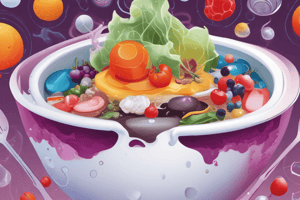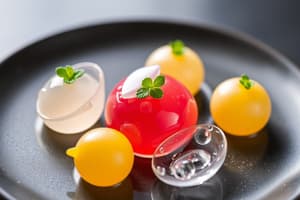Podcast
Questions and Answers
What is typically used as the calcium salt in the reverse spherification process?
What is typically used as the calcium salt in the reverse spherification process?
- Calcium lactate (correct)
- Sodium alginate
- Potassium chloride
- Calcium carbonate
Why is it recommended to freeze the liquid in hemispherical or spherical molds?
Why is it recommended to freeze the liquid in hemispherical or spherical molds?
- To prevent the spheres from breaking apart (correct)
- To make the process more efficient
- To make the spheres stronger
- To create spheres of a uniform size
What is the purpose of combining water with the gelling agent in the setting bath?
What is the purpose of combining water with the gelling agent in the setting bath?
- To set the membrane around the sphere (correct)
- To make the membrane thicker
- To flavor the sphere
- To create a uniform sphere size
Why should the spheres not touch each other in the setting bath?
Why should the spheres not touch each other in the setting bath?
What is the recommended time for small spheres to stay in the setting bath?
What is the recommended time for small spheres to stay in the setting bath?
What happens to the flavor of the spheres if they are stored in plain water for too long?
What happens to the flavor of the spheres if they are stored in plain water for too long?
What is the recommended storage method for spheres that need to be stored for an extended period of time?
What is the recommended storage method for spheres that need to be stored for an extended period of time?
What is the purpose of rinsing the spheres in a water bath after they have set?
What is the purpose of rinsing the spheres in a water bath after they have set?
In reverse spherification, what is used as the gelling agent?
In reverse spherification, what is used as the gelling agent?
What is the result of not freezing the liquid in hemispherical or spherical molds?
What is the result of not freezing the liquid in hemispherical or spherical molds?
Flashcards are hidden until you start studying
Study Notes
Molecular Gastronomy
- Molecular gastronomy focuses on the mechanisms of transformation during culinary processes, unlike traditional food science which focuses on chemical composition and industrial production.
- It aims to generate new knowledge on the chemistry and physics behind culinary processes, and develop new ways of cooking rooted in science.
Molecular Cuisine
- Molecular cuisine, also known as Modernist Cooking, applies the science behind molecular gastronomy to create new techniques in cooking food.
- It helps bring out a new set of flavors and textures, and provides new experiences for diners.
- Chefs like Ferran Adria, considered the father of modernist cooking, use this style of cooking.
Emulsification
- Emulsification is a technique where two liquids that don't mix become combined in a stable way.
- It is a very old cooking technique, used in recipes that include mayonnaise or sauces.
Foaming
- Foaming is a structure that traps air in bubbles, similar to an emulsion which traps fat or liquids in a structure.
- Techniques like agar fluid gels, gelatin, and xanthan gum can be used to create foams with different textures and densities.
Gelling
- Gelling is a wide-ranging and important technique in traditional and modern cooking, taking anywhere from a few minutes to many hours.
- Fluid gels are a special type of gel that behave as both a gel and a liquid, with uses similar to thickened liquids but with different textures.
- Fluid gels can be used to create sauces with a consistency of ketchup or pudding, and stay in place on the plate better than thickened liquids.
Low Temperature Cooking
- Sous vide, or low temperature cooking, is the process of cooking food at a very tightly controlled temperature, normally the temperature the food will be served at.
- It helps achieve texture and doneness not found in other cooking techniques, and provides conveniences for professional kitchens.
- Sous vide has been used in upscale culinary kitchens since the 1970s and is now becoming popular in home kitchens.
Reverse Spherification
- Reverse spherification is a process that combines a calcium salt with a flavored base to create spheres.
- The spheres are frozen, then placed into a setting bath with sodium alginate to create a membrane.
- The spheres can be stored for several hours or overnight in liquid, but the liquid can leech out some of the flavor.
Studying That Suits You
Use AI to generate personalized quizzes and flashcards to suit your learning preferences.




